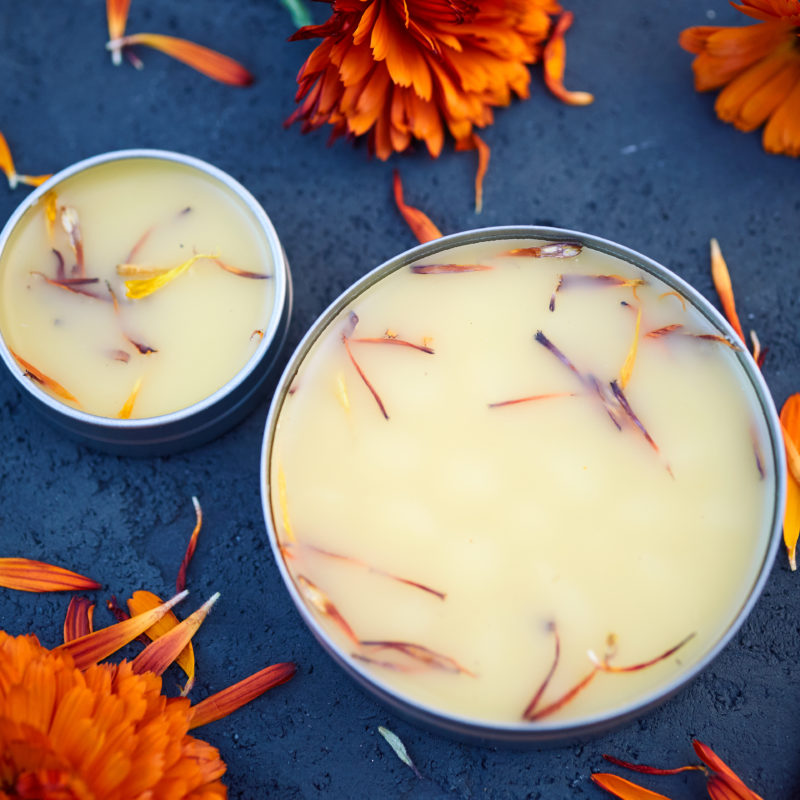
DIY Self-Care Rituals
Find comfort in these DIY self-care projects straight from the garden.

David Fenton
With all that happens during the winter (even in a year where few of us are going anywhere), it’s easy to stop looking after yourself. Seriously, who has the time? Not Stefani Bittner and Kylie Flanagan of the San Francisco Bay Area’s Homestead Design Collective. When days are hectic at the landscape design firm or there’s just too much going on at home, they pluck ingredients from their backyards and whip up simple tonics and salves bursting with vitamins and healing properties.
“The winter garden can be really beautiful and abundant in nutrient-rich plants,” says Bittner, who points to calendula, citrus, parsley, and radicchio as some of her favorites. She often shares what she reaps either as-is, at the table, or incorporated into a simple restorative blend she’s developed with Flanagan.
Try these yourself, using the DIY guide that follows. A light and refreshing salad with dark leafy greens may calm cravings for sweets. A tart and tangy apple cider–based tonic packs immunity-boosting ingredients (bottoms up!). A scented beeswax-based skin soother goes on silky smooth and makes a buzzworthy stocking stuffer for gardeners and non-gardeners alike. For the feet, a good hot soak of citrus, coconut milk, and fragrant herbs awaits weary soles with the promise of utter relaxation. Wrap them up and give them as gifts—and set aside a little something for yourself.

David Fenton
Soothe Your Toes
Our feet do a lot in a day, so take a load off with this relaxing and revitalizing soak. Allow all the colorful and fragrant ingredients—including citrus zest, coconut milk powder, Epsom salts, ginger, and a combination of winter herbs—to work their magic. “When this mixture hits the water, it releases all these scents,” says Bittner. “It’s lovely and soothing.” And it isn’t just for achy arches—feel free to mix into a full tub to steep your entire body. Adding to its versatility, the concoction triples as a gentle exfoliating scrub in the shower. Bittner assures us that it’s easy on sensitive skin, but test it with a small amount first.
Harvest
Pick enough grapefruits, lemons, limes, oranges, or tangerines to cover a cookie sheet with slices. Clean and thinly slice the fruit.Dry
Place slices on a cookie sheet in the oven at 170°, and bake until they are fully dehydrated. Let them cool, then break them up in a coffee grinder or food processor until they resemble a fine dust. (A few chunks are okay.) To speed up the process, you can also order dried citrus wheels online (see “Front-Door Delivery,” below), or just add fresh slices of citrus to the bath.
Mix
In a large bowl, combine 1⁄4 cup of the citrus dust with 1 cup of powdered coconut milk, 2 cups of Epsom salt, 1⁄2 cup of dried calendula petals, 1⁄4 cup each of dried oregano and sage (both finely crushed with your fingers), and 2 teaspoons of powdered ginger. Store dry mixture in an airtight glass jar.
SteepPour 1⁄4 cup of the bath blend into a basin of hot water. Step in, take a deep breath, and enjoy!

Front-Door Delivery
Missing something or can’t find what you’re looking for at your local grocery store or farmers’ market? Purchase dried and fresh ingredients online at Mountain Rose Herbs and BellaViva Orchards.




